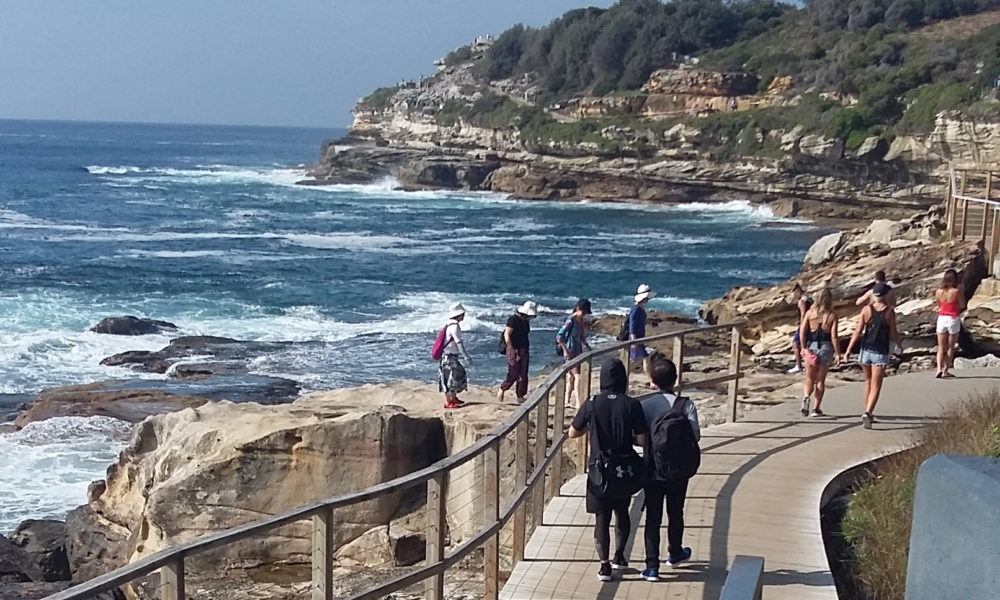
Rough around the edges: The Bondi to Coogee Coastal Walk
The Bondi to Coogee coastal walk is an easily accessible and not too strenuous way to get up close to some of the spectacular coastline in Sydney’s eastern suburbs. The walk hugs the coast for 3 1/2 miles and consists of a gently rolling path with occasional stairs. On sunny days, it provides spectacular photo opportunities and makes for a very enjoyable outing suitable for most ages.
Distance
About 3 1/2 miles hugging the coast the whole way. If you don’t want to walk that far, you can catch a bus either into Coogee or back to Bondi at numerous points along the route.
Time
Walking at a leisurely pace with no stops, you could do the walk in about 2 hours. In reality, though, there are so many scenic overlooks, gorgeous beaches and inlets, and interesting way points that you should budget about 3 1/2 to 4 hours so you can really enjoy the experience. Because the walk connects many popular beaches and recreation spots, there are lots of cafes, kiosks, and other places to grab food and drinks along the way.
Difficulty
In general, the walk is very easy. There are stairs at various points along the way, but you rarely ascend or descend more than two storeys at a time. In addition, since the path runs on the coast in a residential area, there’s always the option to by-pass sections as necessary.
Facilities
At intervals along the path there are potable water spigots to fill up your reusable water bottles. Most beaches have cafes where you can get food and drink. Public toilets are provided at all of the main beaches.
The Walk
Begin the walk anywhere along Bondi Beach, heading in a southwestern direction. (When facing out to sea, southwest is on your right.) Walk down the promenade until you reach the end of the beach, then climb the small set of stairs until you reach the road. Walk down about 25 yards until you are overlooking the seaside pool and sports club.
Stop 1: Bondi Icebergs Club
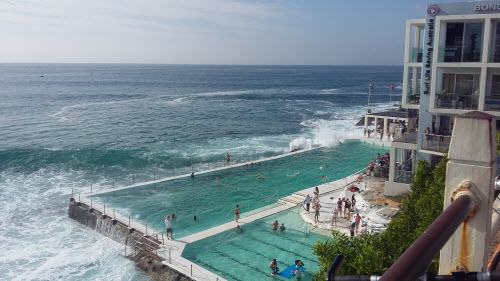
The first stop on the walk is Bondi Icebergs Club. This popular entertainment complex includes an 8-lane lap pool and a smaller 5-lane kids’ pool, both open to the public every day but Thursday. Entry is $7 for adults and $5 for children and towel hire is $3.50. The pools are naturally replenished by the waves that periodically wash into them, so they are, by definition, saltwater pools.
The club is also home to the Bondi Beach Fitness Centre, which has free weights, cardio machines, yoga sessions and, sparring classes. The $20 daily fee includes use of the pools, the locker room, the sauna, and the changing rooms. When I checked it out it was clean, orderly, spacious, and odor-free, so it looks like a good place to go to get your blood pumping. After your workout, you can arrange to get a massage at the Body Spot, located next to the gym.
Beside the gym is The Crabbe Hole cafe, open 7am–3pm weekdays and 7am–5pm on weekends. This walk-up counter offers casual food that you can eat on the terrace as you watch the action in the pools on the level below you. As an added bonus, surfers frequently zip by on waves just 50 meters away from you.
The actual Icebergs Club is on the top floor. It’s open to the public with a bar, a bistro, and gaming. Hours vary by season, so check the website before you decide to go.
Stop 2: Bondi Coastal Boardwalk
Immediately past Icebergs Swim Club, the coastal walk begins with a beautiful boardwalk section that brings you closer to the water’s edge than any other part of the walk.
Stop 3: Bondi Overlook at Mackenzies Point
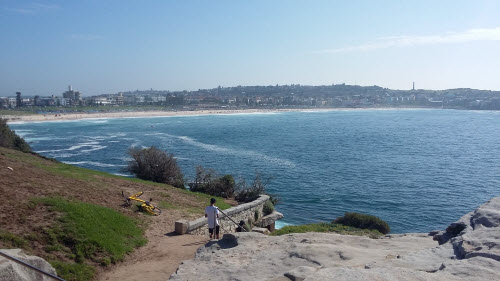
At the end of the boardwalk, you walk along a dirt path for a short while before reaching a short, steep set of stairs. Once you reach the top, you’re at Mackenzies Point. The views back toward Bondi and across the water to North Bondi are excellent from this location.
As you continue around the Point, you come to Mackenzies Bay, which is locally famous as a “pop-up” beach. While it’s normally just a cove filled with jagged rocks, roughly every 7 years or so, currents and tides align just right and a sandy beach forms here, usually with little warning. As soon as the currents change again, the beach disappears.
Stop 4: Bronte Beach Overlook
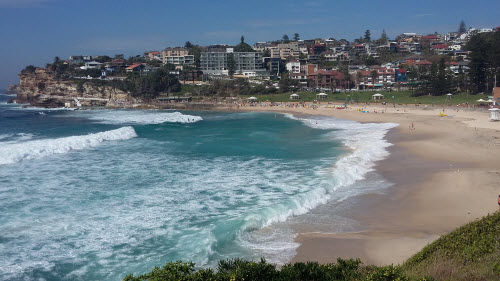
After leaving Mackenzies Point, it’s about a 10-minute walk to Tamarama Beach. Compared to other beaches on this walk, it’s a fairly nondescript place. An additional 15-minute walk brings you to the bluff overlooking Bronte Beach (shown in the image above).
Stop 5: First Surf Lifesaving Club (Bronte Beach)
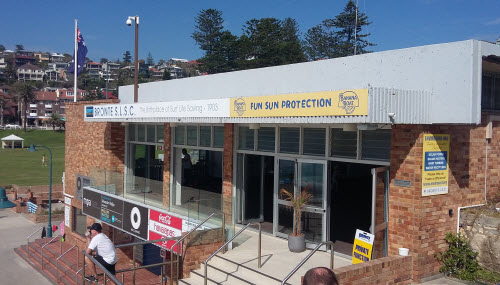
As the path heads downhill toward the sandy part of Bronte Beach, one of the first buildings you come to is the Bronte Surf Life Saving Club. Founded in 1903, it claims to be the oldest surf lifesaving club in the world. That said, though, both Bondi S.L.C. and Manly S.L.C. make the same claim. Regardless, it’s one of the three oldest and has been protecting locals and visitors for over 110 years.
Stop 6: Twice Twist Sculpture
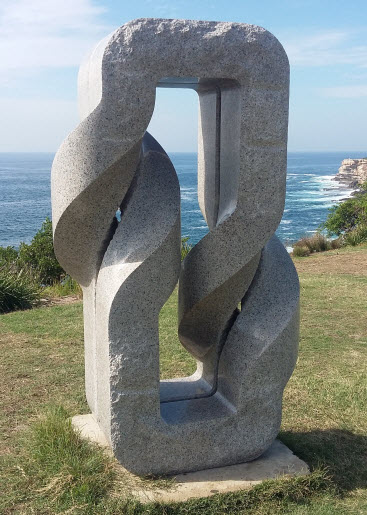
Created by Japanese artist Keizo Ushio in 2012, the Twice Twist sculpture is called Oushi Zokei in Japanese, which is an anagram of the artist’s name. According to a study of Ushio and his works, the words “Oushi Zokei” in Japanese can be interpreted in a variety of ways. “Oushi” can mean “deep truth” and “Zo” can mean “creating” or “forming,” while “Kei” refers to “shape” or “form”. The result is that the name of the sculpture can mean something like “deep truths about the creating of twisted forms.” Anyway you interpret it, it’s a really interesting work, especially seeing how it is carved out of a single block of granite.
Stop 7: Waverly Cemetery
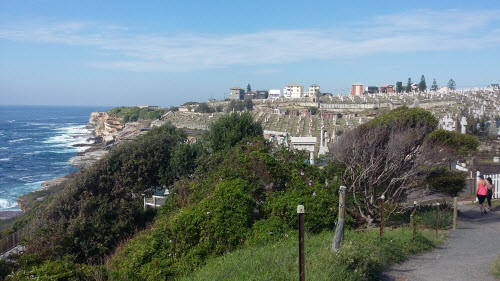
Soon after you leave Ushio’s statue, you have the option to detour into Waverly Cemetery. The graveyard is the final resting place of some of Australia’s most famous literary and political figures. Henry Lawson, often referred to as “Australia’s greatest short story writer” and a popular bush poet is buried here. Lt. George Johnston is also interred here. During the early years of the Australian colony in New South Wales, he was a key figure in defeating the Castle Hill convict rebellion and later in leading the Rum Rebellion in 1808. In the same area of the cemetery you can also find the graves of Sir Francis Forbes, first Chief Justice of the Supreme Court of New South Wales and Dorothea Mackellar, whose poem, “My Country,” contains the oft-quoted lines:
I love a sunburnt country
A land of sweeping plains,
Of ragged mountain ranges,
Of droughts and flooding rains— My Country (1911)
Stop 8: Clovelly Beach
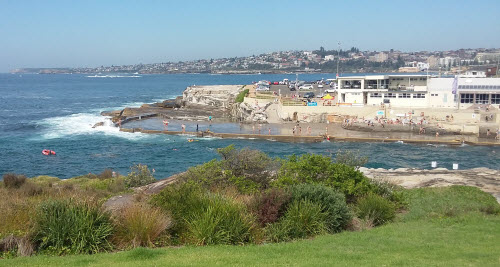
After leaving the cemetery, or by-passing it by taking the shore walk, continue along until you come to Clovelly Beach. This is a great place to stop and have lunch. The option with the biggest selection and best view is the Seasalt Cafe, which offers casual dining on a shaded terrace overlooking the swimming bay. For more casual meals, they also have a walk-up kiosk where you can get food to go.
The swimming area at Clovelly Beach is unusual but also less intimidating for those who aren’t so sure about swimming in the ocean. One side of the swimming bay is cemented over, like a swimming pool, complete with sheltered ladders to make it easy and safe to get in and out. The Clovelly surf life saving crew is set up at the edge of the pool, so they are ready to help the moment they might be needed.
Stop 9: Gordons Bay
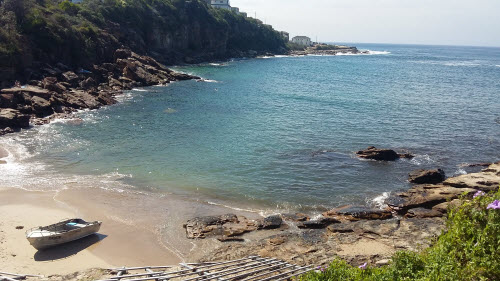
Gordons Bay is a tiny cove about a 15-minute walk from Clovelly Beach. Named after Lewis Gordon, an Australian surveyor who was awarded land here in the middle of the nineteenth century. With boats beached on the sand and others tied to log ramps above the high-water mark, there’s not a lot of room to sunbathe here. It is, however, extremely picturesque and well worth stopping to take photos and grab a drink of water.
Stop 10: Dunningham Reserve
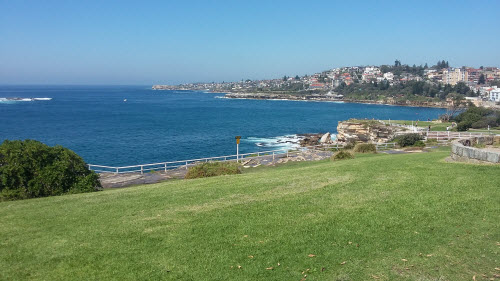
Not far from Gordons Bay is the flat, park-like expanse of Dunningham Reserve that heralds your arrival on the outskirts of Coogee Beach. This area offers terrific views of the shoreline extending beyond Coogee. The site of a “modern” gym, health center, and baths complex built in 1928 (and demolished in 2000), the area is now home to the Bali Bombing Memorial.
Stop 11: Bali Bombing Memorial
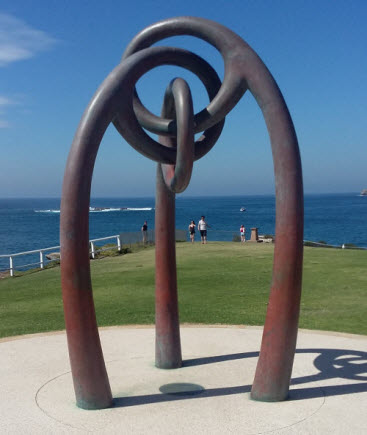
Dedicated in October 2003 to the memory of all of those killed in the October 2012 Bali bombing, this memorial is especially poignant given that 20 of the 88 Australians killed were from Coogee and the nearby suburb of Malabar. The memorial plaque beside the sculpture describes what it represents:
The linked figures in this sculpture signify family, friends and community. Bowed in sorrow and remembrance, they comfort, support and protect each other. The figures also symbolise life, growth, hope and our strength in unity.
Stop 11: Coogee Beach
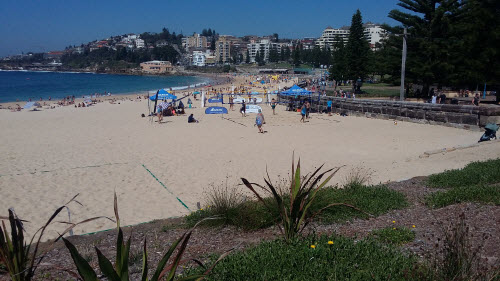
The last stop on the walk is Coogee Beach, itself. Consisting of a broad sandy beach with safe swimming conditions, it’s a very popular place for Sydney-siders during the summer. In 1935, it gained international attention when a tiger shark at the Coogee Aquarium Baths (no longer in existence) regurgitated a human arm. Since the arm had been cut off, not torn off by the shark, its discovery led to a murder investigation. Although the victim was identified based on a tattoo on the arm, the murderer was never found. And no, I have no idea what happened to the shark.
So that’s it. Your background scoop for many of the highlights of the Bondi to Coogee Coastal Walk. If you’ve enjoyed this blog post, stay tuned for the Manly Headlands Bush Walk post coming up next week.
Join the conversation! 1 Comment
Comments are closed.
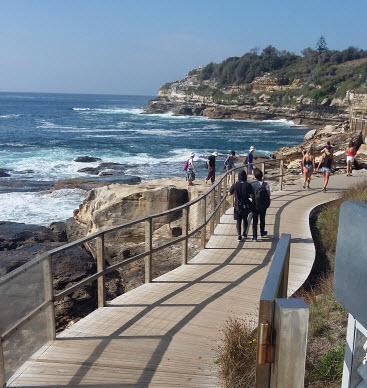
[…] while “Kei” refers to “shape” or “form”. This is just one of the highlights of the Bondi to Coogee Coastal Walk near Sydney, […]